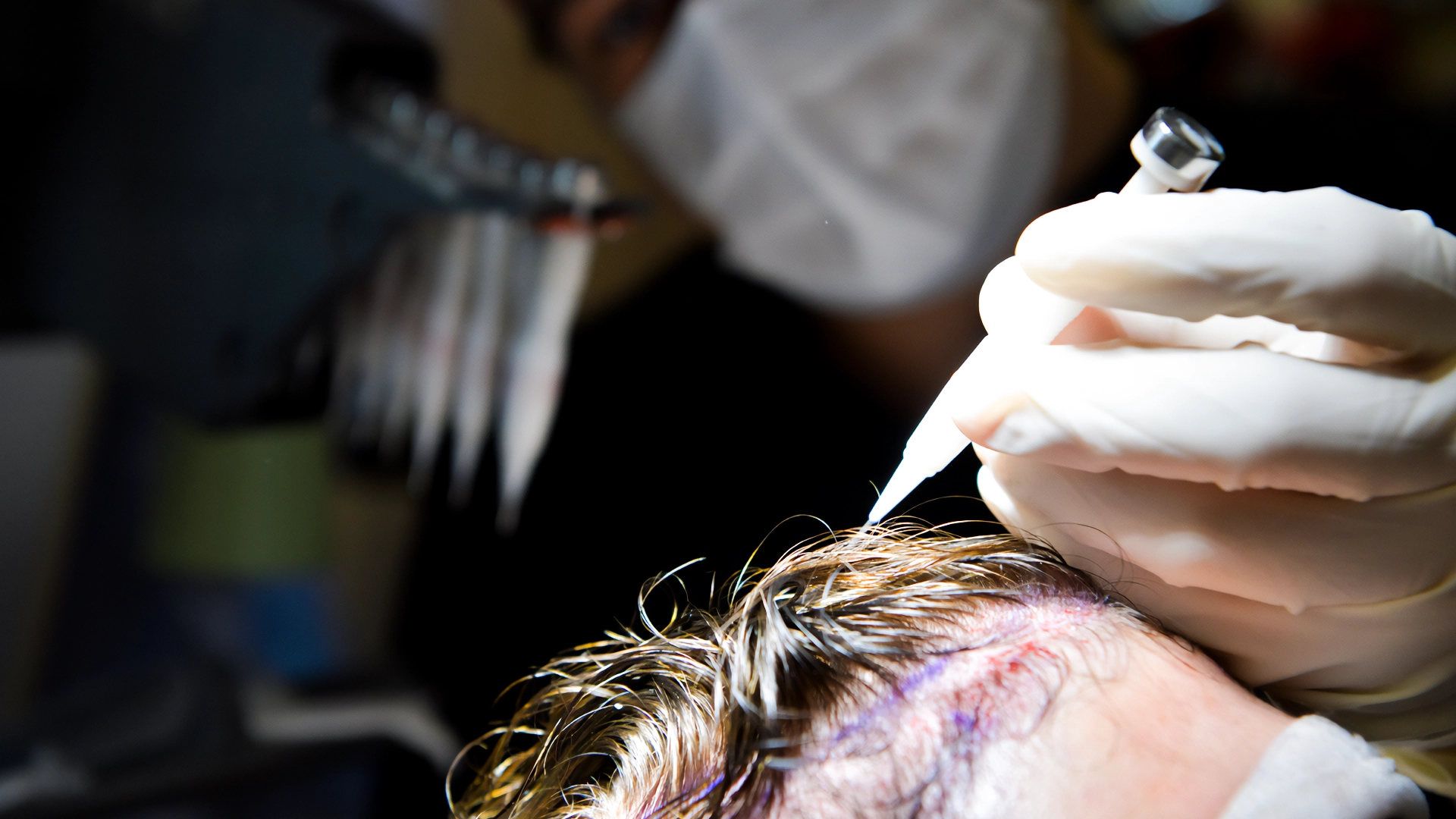Unshaven Hair Transplant in Turkey
Table of Contents

Unshaven Hair Transplant in Turkey
Unshaven hair transplant in Turkey is a specialized technique that allows hair restoration without completely shaving the head. This method is ideal for individuals who want to maintain their existing hairstyle while undergoing a hair transplant. Unlike traditional techniques, unshaven hair transplant in Turkey only trims the donor area, making the procedure more discreet. Patients can return to daily life without noticeable signs of surgery, as the surrounding hair conceals the transplanted areas. This approach is particularly popular among professionals and individuals who prefer to keep their appearance unchanged during the recovery process.
The procedure follows the same principles as FUE or Sapphire FUE but requires greater precision due to limited visibility. Surgeons carefully extract and implant hair follicles while ensuring natural density and proper angulation. Since the hair is not fully shaved, the process takes longer and requires highly skilled specialists. Healing time remains similar to other hair transplant methods, but careful post-operative care is essential to protect the existing hair. Unshaven hair transplantation in Turkey is an excellent option for those seeking natural results while preserving their current hairstyle.
However, with the unshaven hair transplant in Turkey method, this requirement is eliminated, and the procedure is carried out while preserving the existing hair. This method is an ideal solution for individuals who have aesthetic concerns and do not want their hair to be shaved.
Advantages of Unshaven Hair Transplant
The advantages of unshaven hair transplant include a discreet procedure, faster social reintegration, and maintaining the patient’s existing hairstyle. Unlike traditional methods, this technique does not require a full shave, allowing patients to undergo a hair transplant without drastic changes in appearance. Since the surrounding hair remains untouched, the transplanted areas blend seamlessly, making post-procedure healing less noticeable. This approach is particularly beneficial for individuals who prefer to keep their daily routines and professional image intact. It offers a confidence boost by ensuring that hair restoration remains private while delivering natural and permanent results.
Unshaven hair transplantation allows patients to avoid the psychological discomfort associated with sudden changes in hair length. The ability to maintain a normal look during the recovery period makes this technique a preferred choice for many. Since only the donor area is trimmed, the patient experiences minimal disruption to their appearance. This technique requires advanced surgical precision, ensuring that transplanted follicles are placed carefully for optimal density and growth.
A Step-by-Step Guide to the Unshaven Hair Transplant Procedure
A step-by-step guide to the unshaven hair transplant procedure begins with an initial consultation to assess hair loss and donor area suitability. The surgeon examines the scalp, discusses expectations, and plans the procedure based on the patient’s hair characteristics. On the day of the surgery, only a small section of the donor area is trimmed while the rest of the hair remains untouched. Local anesthesia is applied to numb the scalp, ensuring a painless experience during the extraction and implantation process. Using the FUE or Sapphire FUE technique, individual hair follicles are carefully extracted from the donor area with precision.
Once the grafts are collected, the surgeon creates micro-incisions in the recipient area following the natural hair growth pattern. The extracted follicles are then implanted strategically to ensure a natural-looking density and seamless blending with existing hair. Since the surrounding hair is left intact, the transplanted area remains discreet and blends naturally during the healing process. After the procedure, patients receive post-operative care instructions to protect the scalp and promote healthy hair growth. The recovery period is similar to traditional methods, with minor redness and scabbing that gradually fade within weeks.
Over the following months, the transplanted hair integrates with existing strands, growing naturally and blending perfectly with the surrounding hair. Full results become visible as the new follicles strengthen and produce permanent, healthy hair growth. The unshaven hair transplant procedure offers a subtle yet effective way to restore hair while maintaining the patient’s current appearance.
Unshaven Hair Transplant vs. Traditional Methods
Unshaven hair transplant differs from traditional methods by allowing hair restoration without shaving the entire scalp, maintaining the patient’s current appearance. Unlike conventional FUE or FUT techniques, which require complete shaving for better visibility, unshaven transplantation only trims the donor area. This approach ensures that transplanted follicles blend seamlessly with existing hair, making the healing process more discreet. Patients who prefer to keep their hairstyle unchanged during recovery find this method ideal for maintaining social and professional routines. The unshaven technique is particularly beneficial for individuals who want to avoid the psychological impact of a sudden change in hair length.
Traditional methods provide excellent results but often require a longer adjustment period due to the visible effects of a fully shaved scalp. With unshaven hair transplantation, there is no drastic transformation, allowing patients to undergo the procedure without drawing attention. However, this method requires greater surgical precision as surgeons must carefully navigate existing hair while implanting new follicles. Since fewer grafts are extracted per session, the procedure may take longer than traditional FUE or FUT.
Understanding the Recovery Process After an Unshaven Hair Transplant
Understanding the recovery process after an unshaven hair transplant is essential for ensuring optimal healing and long-lasting results. Since the surrounding hair remains intact, the healing process is more discreet, allowing patients to return to daily activities sooner. Mild redness, swelling, and scabbing may appear in the treated areas, but these symptoms subside within a few days. Proper scalp care, including gentle washing and avoiding excessive touching, helps prevent irritation and ensures a smooth recovery. Patients should follow their surgeon’s aftercare instructions to protect the newly transplanted follicles and promote healthy hair growth.
During the first few weeks, transplanted hair may go through a shedding phase, which is a natural part of the process. This temporary loss occurs as the follicles adjust and prepare for new hair growth in the coming months. The scalp gradually heals, and within a few months, the transplanted hair begins to grow naturally and blend with existing strands. Full results typically become visible within 6 to 12 months as the new follicles strengthen and produce permanent hair.
How Long Does an Unshaven Hair Transplant Take?
An unshaven hair transplant typically takes between 6 to 10 hours, depending on the number of grafts and the complexity of the procedure. Since the surrounding hair remains intact, surgeons must work with extreme precision to extract and implant follicles without disrupting existing strands. This meticulous process requires additional time compared to traditional methods, where the entire scalp is shaved for easier access. Each hair follicle is carefully harvested using advanced FUE or Sapphire FUE techniques to ensure a natural-looking result. The implantation stage is equally detailed, as the surgeon must place each graft at the correct angle and density.
The total duration of the procedure varies based on factors such as hair thickness, the size of the recipient area, and the patient’s specific needs. A larger number of grafts means a longer session, as each follicle must be handled with care to maintain viability. Some cases may require breaks to ensure patient comfort, which can slightly extend the overall time. Despite the extended duration, the unshaven technique provides a seamless transition, allowing patients to maintain their appearance throughout the recovery period.
Who is Suitable for Unshaven Hair Transplant
Hair transplant without shaving is suitable for individuals who have aesthetic concerns, do not want their hair to be shaved, or prefer long hair styles. Additionally, this method is preferred especially by people with minimal hair loss and individuals with an active social life. It also stands out as an ideal hair transplant option for women.
Does Unshaven Hair Transplant Leave Scars?
An unshaven hair transplant does not leave visible scars when performed using advanced FUE or Sapphire FUE techniques. The precision of Sapphire FUE further reduces scarring by using ultra-fine blades to create smaller, more refined incisions. This method promotes faster healing and minimizes trauma to the surrounding tissue, ensuring a smooth recovery. Patients who follow proper aftercare, including gentle washing and avoiding excessive friction, help optimize healing and prevent irritation. Once the scalp fully recovers, the transplanted hair grows naturally without any visible signs of surgery. The unshaven hair transplant technique provides a discreet and effective solution for those seeking hair restoration without noticeable scarring.
Is Unshaven Hair Transplant Painful?
An unshaven hair transplant is not painful because the procedure is performed under local anesthesia, ensuring patient comfort throughout the process. The numbing injections prevent any sensation during follicle extraction and implantation, making the surgery completely tolerable. Some patients may feel mild pressure or vibrations as the surgeon works, but no significant discomfort occurs. After the procedure, minor tenderness or tightness in the treated areas is normal and usually subsides within a few days. Any post-operative sensitivity can be managed with prescribed pain relievers and proper scalp care.
Since unshaven hair transplantation is a minimally invasive technique, the healing process is generally smooth and without severe pain. Patients may experience slight redness or mild swelling, which naturally fades as the scalp recovers. Avoiding direct sun exposure, heavy physical activity, and unnecessary touching helps prevent irritation and promotes faster healing. Most individuals return to their daily routines within a few days, with no long-term discomfort.
How Soon Can You See Results After an Unshaven Hair Transplant?
Results after an unshaven hair transplant become noticeable gradually, with initial changes appearing within a few weeks and full growth taking months. In the first few days, mild redness and scabbing may occur as the scalp begins the healing process. Around two to three weeks after the procedure, some transplanted hairs enter the shedding phase, which is a normal part of follicle adaptation. New hair growth typically starts within three to four months as the follicles strengthen and settle into their natural cycle. By six months, the hair begins to thicken, blending seamlessly with existing strands for a more uniform look.
Final results become fully visible between 9 to 12 months, as the transplanted follicles mature and achieve maximum density. Since the surrounding hair remains intact, the transition appears more natural compared to fully shaved procedures. Proper post-operative care, including scalp protection and a healthy lifestyle, helps accelerate hair growth and improves overall results. The gradual progression ensures that the new hair integrates smoothly, enhancing the appearance without drastic changes.
Unshaven Hair Transplant in Turkey Cost 2025
The cost of unshaved hair transplant in Turkey 2025 varies depending on the number of grafts required. The no-shave technique allows patients to maintain their current hairstyle during the procedure, offering a different option for those who want to have a hair transplant. Türkiye’s experienced surgeons and state-of-the-art clinics continue to attract individuals worldwide seeking quality hair transplant procedures.













